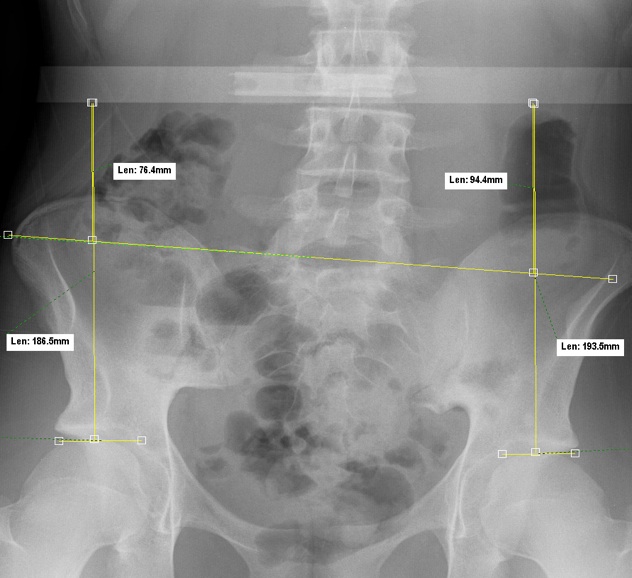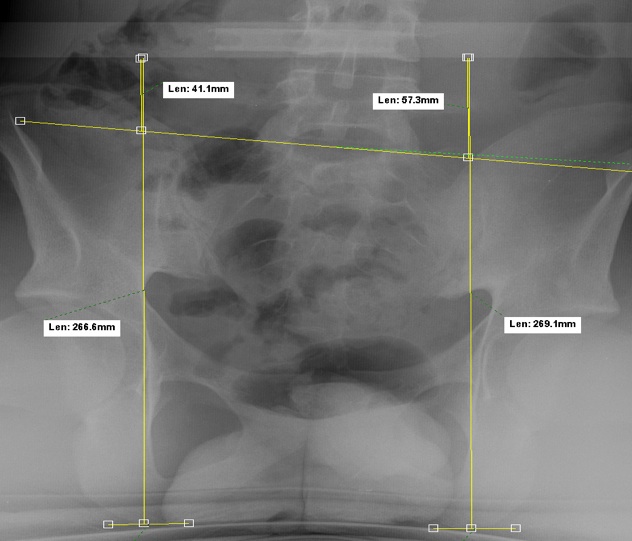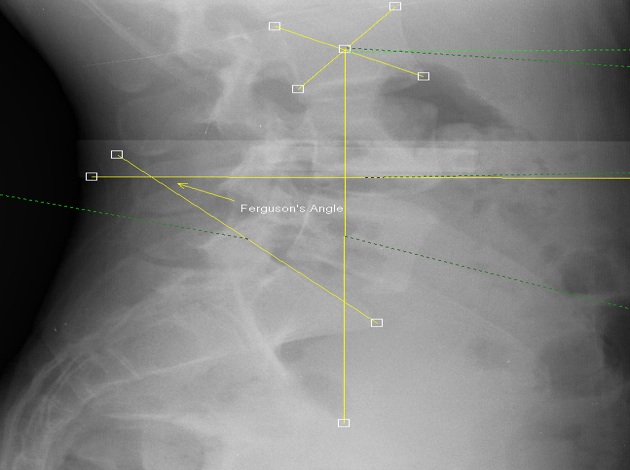Postural Study

Standing:
1.A horizontal line through the lower lumbar spine is provided.
2.Draw a horizontal line through the sacral sulci.
3.Draw a horizontal line along the superior aspect of the femoral heads. (Reason: the femoral heads are the weight bearing surface in the standing position)
4.Draw and measure vertical lines from the superior aspects of the femoral heads connecting to the horizontal lines overlying the lumbar spine. If these lines were to extend inferiorly, they would bisect the femoral heads.
5.Calculate the difference between the lines measured in step 4. This is femoral head unleveling.
6.Draw and measure the distances from the horizontal line overlying the lumbar spine to the point where the line through the sacral base intersects the vertical line through the femoral heads.
7.Calculate the difference between the lines measured in step 6. This is the sacral base unleveling. The side that is “unlevel” is the lower side, for example “the line measuring 94.4 mm” in the radiograph above.
1.A horizontal line through the lower lumbar spine is provided.
2.Draw a horizontal line through the sacral sulci.
3.Draw a horizontal line along the superior aspect of the femoral heads. (Reason: the femoral heads are the weight bearing surface in the standing position)
4.Draw and measure vertical lines from the superior aspects of the femoral heads connecting to the horizontal lines overlying the lumbar spine. If these lines were to extend inferiorly, they would bisect the femoral heads.
5.Calculate the difference between the lines measured in step 4. This is femoral head unleveling.
6.Draw and measure the distances from the horizontal line overlying the lumbar spine to the point where the line through the sacral base intersects the vertical line through the femoral heads.
7.Calculate the difference between the lines measured in step 6. This is the sacral base unleveling. The side that is “unlevel” is the lower side, for example “the line measuring 94.4 mm” in the radiograph above.

Seated
1.Draw a line through the sacral base as done for the standing view.
2.Draw horizontal lines through the inferior aspect of the ischial tuberosities.
3.Draw vertical lines from the horizontal line overlying the lumbar spine through the mid-ischial tuberosities. (Reason: The ischial tuberosities are the weight bearing surfaces in the sitting position)
4.Measure the distances from the horizontal line overlying the lumbar spine to the line drawn through the sacral base and calculate the difference. This is the sacral base unleveling in the sitting position.
1.Draw a line through the sacral base as done for the standing view.
2.Draw horizontal lines through the inferior aspect of the ischial tuberosities.
3.Draw vertical lines from the horizontal line overlying the lumbar spine through the mid-ischial tuberosities. (Reason: The ischial tuberosities are the weight bearing surfaces in the sitting position)
4.Measure the distances from the horizontal line overlying the lumbar spine to the line drawn through the sacral base and calculate the difference. This is the sacral base unleveling in the sitting position.

Lateral
1.Draw two lines through the L3 vertebral body as in the above example.
2.Draw a line extending straight inferiorly from the point that these two lines intersect. This line should normally extend through the anterior 1/3 of the sacral base. If it is anterior to this, it is an anteriorly shifted weight bearing line. If posterior, it is a posteriorly shifted weight bearing line.
3.Draw a horizontal line along the given horizontal line overlying the lumbar spine.
4.Draw a line extending from the anterior point of the sacral base to the posterior point of the sacral base that extends and intersects the given horizontal line.
5.Click on the angle button on the bottom toolbar to measure “Ferguson’s Angle” (as in the above example).
1.Draw two lines through the L3 vertebral body as in the above example.
2.Draw a line extending straight inferiorly from the point that these two lines intersect. This line should normally extend through the anterior 1/3 of the sacral base. If it is anterior to this, it is an anteriorly shifted weight bearing line. If posterior, it is a posteriorly shifted weight bearing line.
3.Draw a horizontal line along the given horizontal line overlying the lumbar spine.
4.Draw a line extending from the anterior point of the sacral base to the posterior point of the sacral base that extends and intersects the given horizontal line.
5.Click on the angle button on the bottom toolbar to measure “Ferguson’s Angle” (as in the above example).







